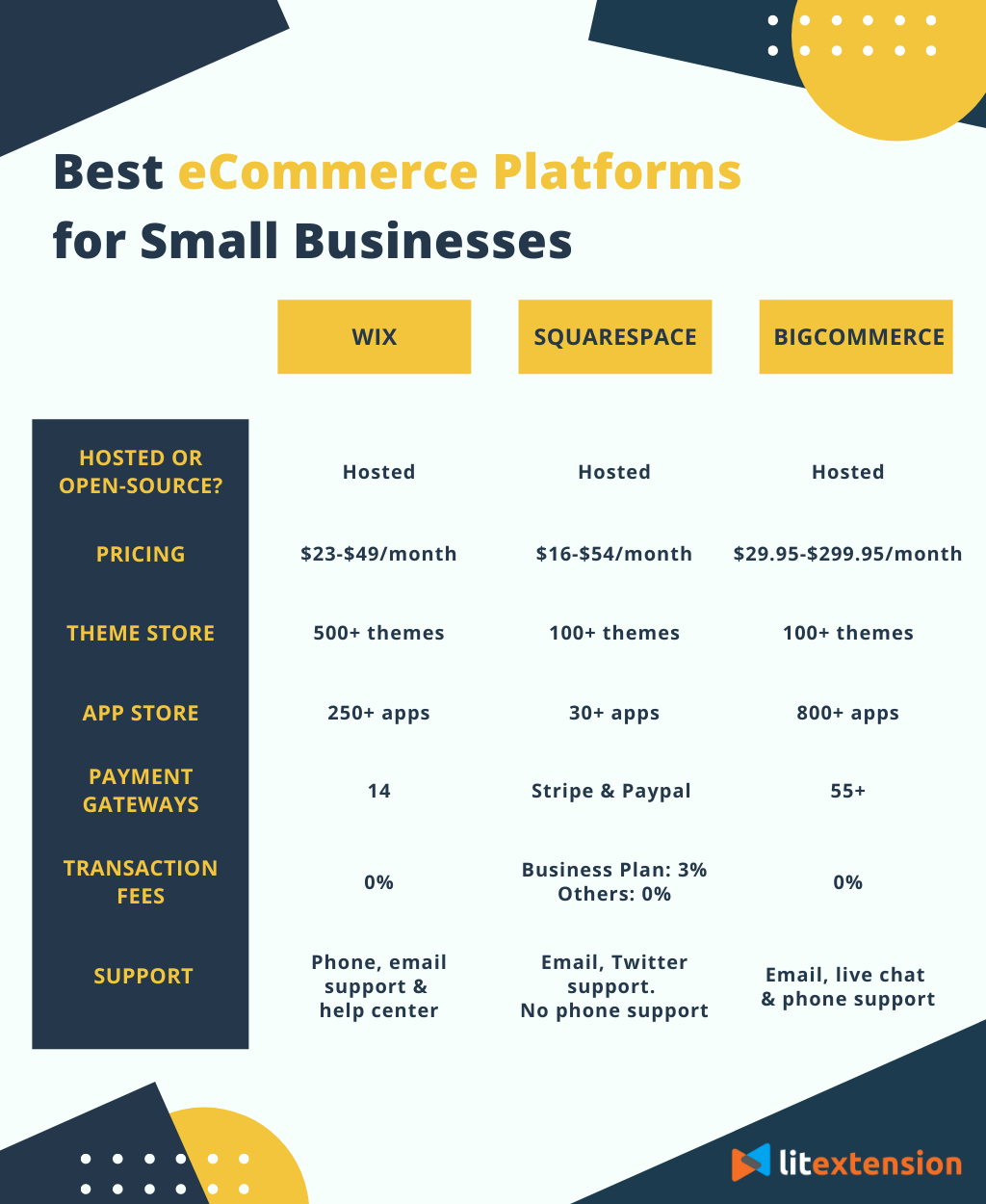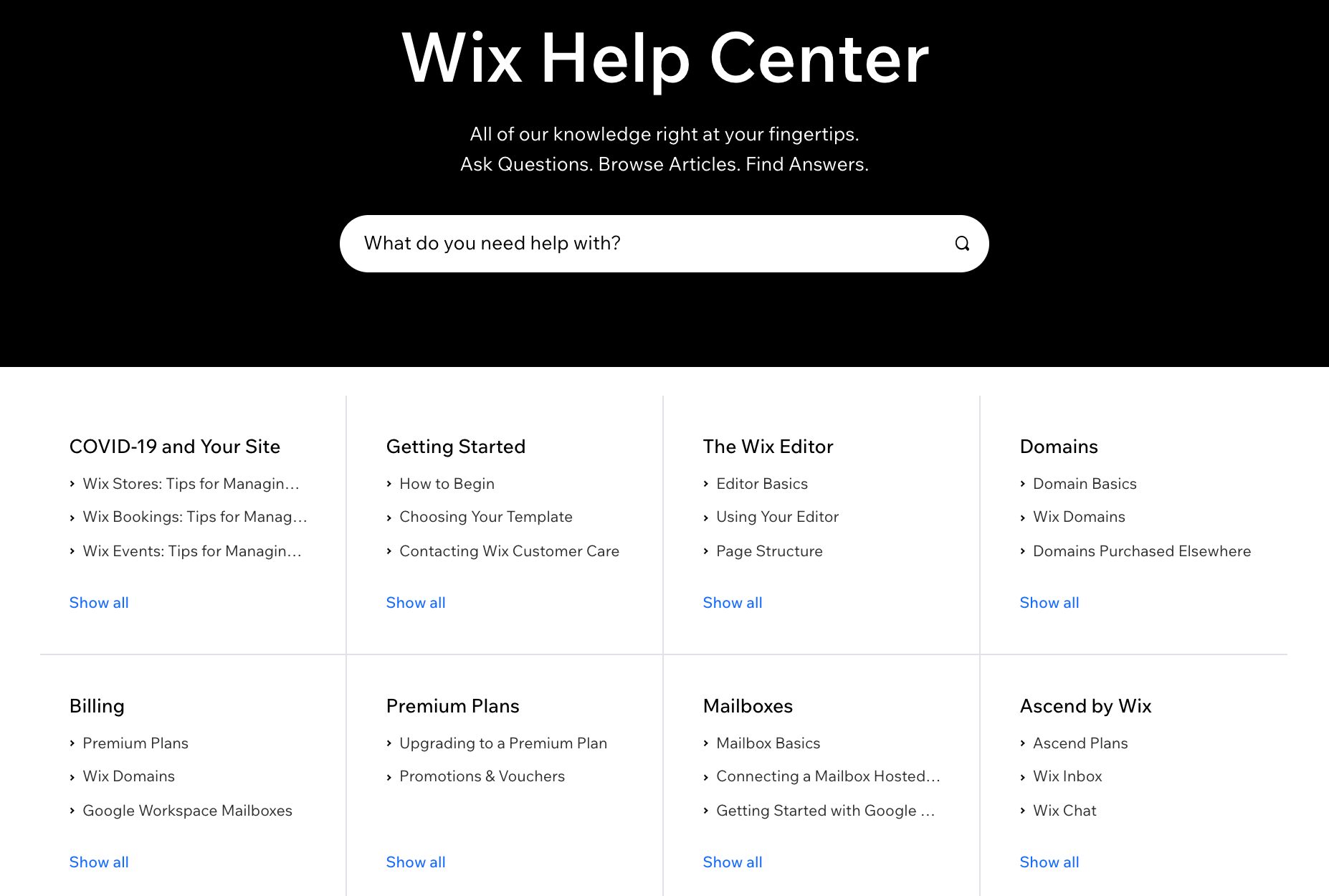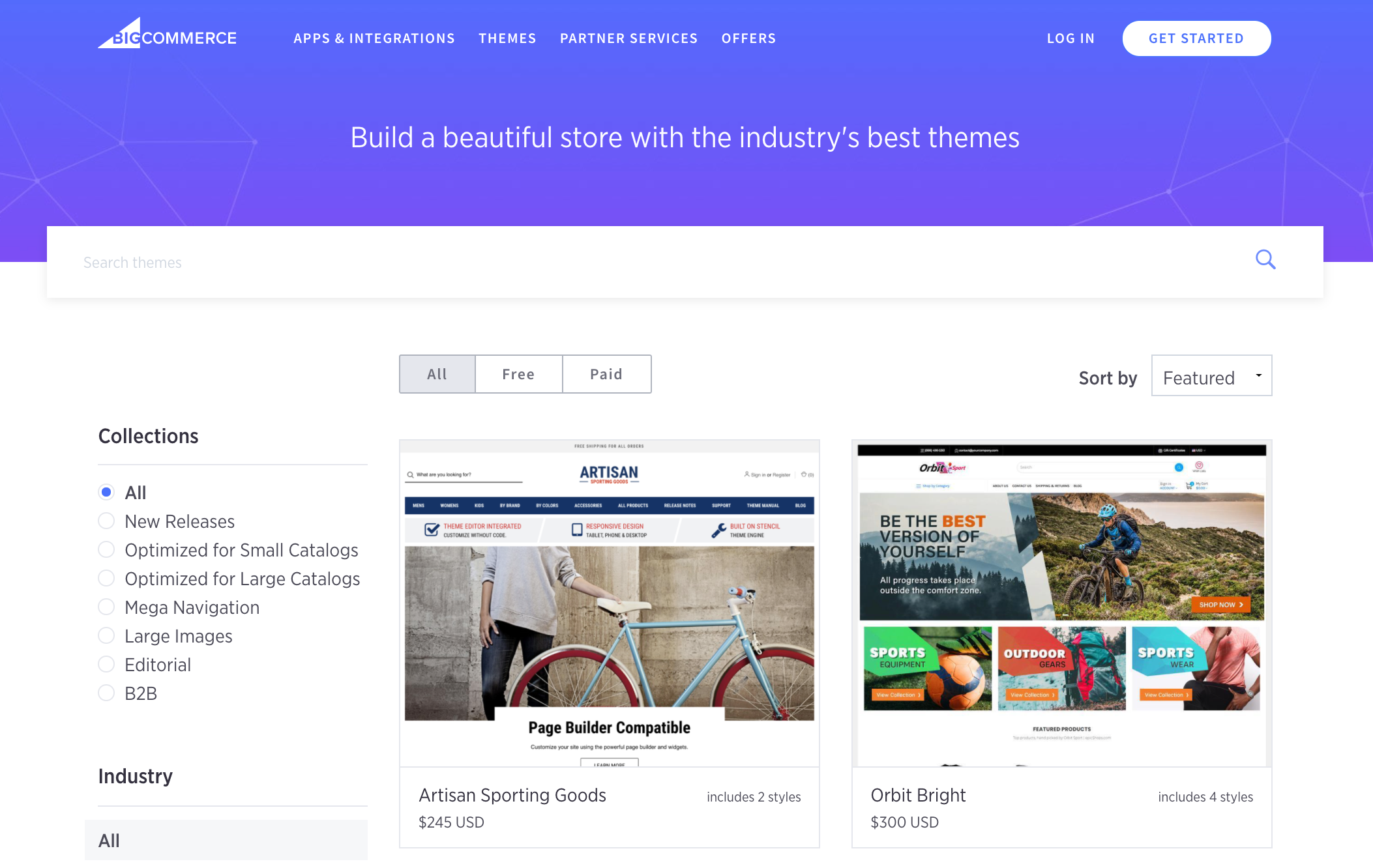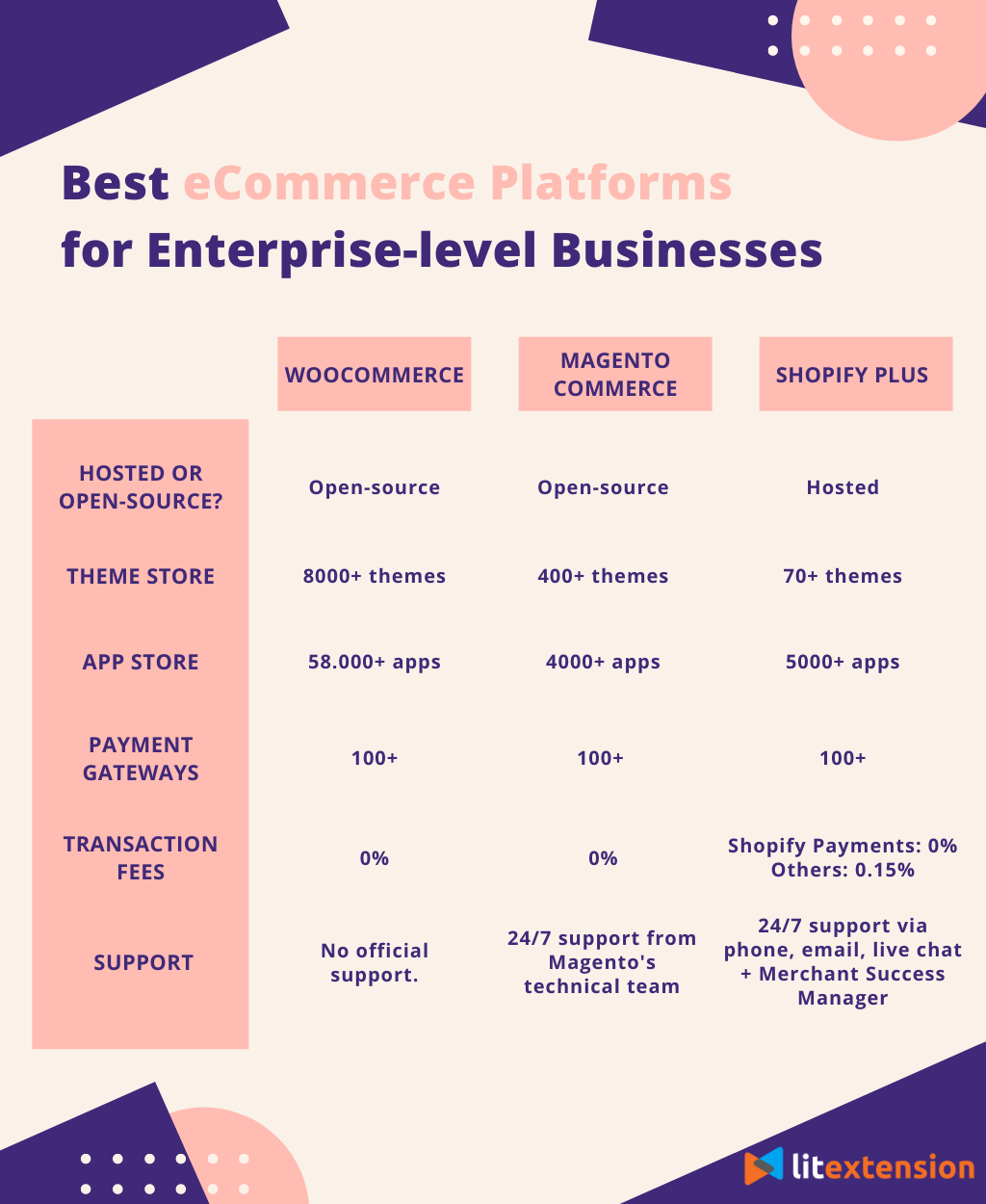Introduction
There is a good chance you’re here because you’re about to dip your toes into the eCommerce world and you’re wondering which platform is ideal to get started with. Or your business has grown out of what the current platform has to offer and thus, you’re busy doing research to choose the right eCommerce platform for your enterprise-sized business. If any of that sounds like you, then you’d better keep scrolling down.
In this write-up, LitExtension – the world #1 shopping cart migration expert will be providing you with:
- Things to consider when choosing an eCommerce platform based on business size
- A rudiment about these recommended platforms
- Pros & Cons of each solution.
All right, now is the time to get this show on the road. Fasten your seatbelt, grab some drink as it’s going to be quite a long read!
3 Best eCommerce Platforms for Small Businesses
Choosing an eCommerce platform is a lot like choosing a location or home base for your brick-and-mortar business. There are lots of factors that need taking into account, from pricing, built-in eCommerce features to the level of support you can expect when bringing your business to life.
If you are a small business owner, it’s pretty sure that you’ll prefer hosted solutions over open-source solutions. These hosted solutions are generally less problematic and troublesome for amateur users.
In this article, we’ll be looking at three hosted solutions: Wix, Squarespace & BigCommerce. From our research and customers’ review, these eCommerce platforms are all value for money and performance.
But if you’re in a rush, you can compare the three best eCommerce platforms for small businesses side by side in our infographic below.
Wix
Wix might not be the most advanced solution for eCommerce website building – but it’s the icing on the cake for store owners to get started. It’s not only uber-easy to use but also versatile.
Here is our Wix tutorial video to help you quickly get off the ground:
There are tons of features that you get with Wix, including a drag and drop store builder, hundreds of stunning templates, and a mobile-optimized performance.
Yet, despite a wealth of attributes, Wix is surprisingly affordable with a range of packages to choose from.

There is also a totally free package too, but it requires displaying ads on your website. However, to sell products, you need to use Business & eCommerce Plans or Enterprise Plans rather than Website Plans.
For as low as $23 per month, you’ll have all the tools you need to sell online, from basics like product management, accepting online payments to extras like analytics and an automated tax calculator.
Besides, with a robust market of over 300 free and paid apps, you can even upgrade and customize your e-store that oozes real personality.
Although Wix’s eCommerce features are relatively advanced, they can’t compare to platforms that are entirely eCommerce-focused like Shopify or WooCommerce. But this is to be expected from a solution that is mainly designed for beginners and mid-level users.
With Wix, you can rest assured knowing that this hosted solution has a high-quality support system. You can contact Wix’s in-house support team directly over phone or mail, from Monday to Thursday.
In addition to direct support, Wix also offers a bunch of helpful resources and video tutorials on its help center.
Wix Pros
- Its drag-and-drop building tool makes its editor extremely easy to use for all-level users.
- Compared to hosted solutions like Shopify, Wix is more reasonably priced.
Wix Cons
- Wix doesn’t allow switching templates once the site is live, making redesigns tricky.
Further reading:
Squarespace
Just like Wix, Squarespace is also a drag-and-drop website builder where all the templates, attributes and security measures are provided out of the box.
Nonetheless, Squarespace provides more advanced features which means there is a slightly steeper learning curve. But with a tech background, you’ll pick up Squarespace quite quickly.
Squarespace still caters to small and mid-sized businesses, but it supports an unlimited number of products and transactions.
Not only that, if you choose the Basic Commerce package instead of the Business plan, you can avoid transaction fees completely.
Below is a comparison chart of 4 Squarespace pricing plans that you might want to take a look.
What we believe is Squarespace’s strong suit is its decent collection of sleek and stylish templates.
Squarespace has around 110 templates, which seems like a small number compared to its competitors – Shopify, Wix or WordPress. However, Squarespace goes for quality over quantity – and succeeds beautifully.
Moreover, you’re able to stamp your mark on your site by adding some twists to your design, from text fonts and color palettes to background images. And whenever you feel your website is in need of a revamp, you can switch your cover page without a hitch.
With regard to features, those Squarespace features are not that plentiful or advanced, but pretty much cover all the bases. With Squarespace, you can enjoy the “everything is included” approach with all business-crucial functions packaged in.
You can refer to our head-to-head comparison video between Wix vs Squarespace below for more insights.
Squarespace Pros
- Though Squarespace lacks phone support, you can get 24/7 support via email and Twitter. There’s also a library of help guides where you can find insightful responses to almost every question.
- All domains connected to Squarespace are protected with free Secure Sockets Layer certificates. Besides, Squarespace also provides two-factor authentication, which adds an extra layer of security to your personal and financial information.
Squarespace Cons
- Squarespace doesn’t support payment via Google Pay yet. This platform doesn’t facilitate multi-currency payments as well.
Further reading:
BigCommerce
If you’re planning to build an online shop and sell across multiple channels, then BigCommerce could be just the tool for you.
Being a fully hosted platform, BigCommerce doesn’t require hosting and software installation. The same thing happens for security and ongoing maintenance.
When it comes to eCommerce features, it would be no exaggeration to say that BigCommerce has the best in-house features of any platform. That means you won’t have to heavily rely on third-party apps like with Shopify.
The thing is you need to ensure you have the skill required to take advantage of all the benefits that BigCommerce has to offer.
Here are a few key eCommerce features of BigCommerce:
- Multi-channel Integration: You can sell directly on other channels like Facebook, Amazon or eBay right from your site. This lets you expand your store’s reach while still keeping costs low.
- Cart Abandonment Alerts: When your customers abandon items in their cart, you can send an automated email to draw them back to their purchase.
- Analytical Tracking & Reporting Tools: You can manage site performance through sessions, sales and emails.
In addition, BigCommerce ensures you a good-looking and eye-catching storefront with a decent collection of 5 free themes and 100+ paid themes (with various theme variations). However, the price range for BigCommerce paid themes is from $145 to $235, which is pretty high compared to other hosted solutions.
The good thing is you can make use of BigCommerce’s 15-day free trial to try out its powerful features. After the trial period expires, BigCommerce offers you three pricing packages to choose from.
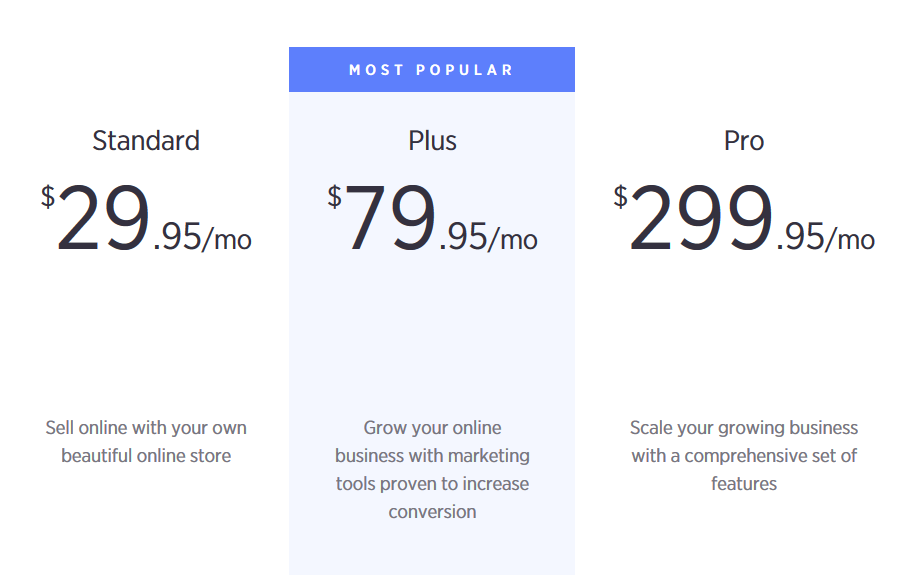
The great news is that all BigCommerce plans charge no transaction fees and if you opt for paying annually instead of monthly, you’ll get a 10% discount.
BigCommerce Pros
- You’ll receive support around the clock via email, live chat and phone.
- In comparison with Wix or Squarespace, BigCommerce has a larger number of apps & plugins.
BigCommerce Cons
- It can be tricky to get to grips with at first. Thus, BigCommerce is not a “quick eCommerce fix”.
Further reading:
- BigCommerce Review
- BigCommerce Tutorial for Beginners
- All You Need to Know about BigCommerce Pricing
3 Best Enterprise eCommerce Platforms
An enterprise eCommerce platform needs to handle a myriad of tasks, from rendering multiple product categories, managing inventory to connecting with third-party systems. The complexity of these tasks is compounded as you factor in large order volumes and different currencies.
Therefore, enterprise-grade businesses typically need additional features and tend to prioritize flexibility and customizability over ease of use and pricing.
From our research, WooCommerce, Magento Commerce and Shopify Plus are the 3 best platforms for enterprise-level businesses.
You can take a look at our comparison below, and then read on to explore more details on each platform’s notable features, pros & cons.
WooCommerce
As a WordPress plugin, WooCommerce serves as a bridge that turns any WordPress site into an eCommerce store.
WooCommerce is free to download and use. But it’s not an entirely free ride as you still have to pay for some extras like domain, hosting, security as well as some efficiency-enhancing features.
Below is the 10-minute WooCommerce tutorial to help you get started quickly:
One of the main reasons why enterprise-level businesses prefer WooCommerce over other hosted solutions like Shopify, BigCommerce lies within its endless customization possibilities.
Regarding the online presence of your store, you can not only access the humongous library of WordPress themes but also be able to tweak it at your will.
Should you feel overwhelmed due to a glut of options, you can take a look at the best WooCommerce themes in 2021 for some suggestions.
Besides over 58,000 apps available on the marketplace, this platform also allows you to create your own to meet your specific requirements. You can also share it or sell it to other WooCommerce users.
Its great degree of flexibility and customizability also applies when it comes to sales features. With WooCommerce, you can make changes to any attributes of products. In fact, there are no limitations on how many variable products you can create.
Thus, WooCommerce is an appropriate solution for large-scale businesses with a high volume of selling products and orders.
WooCommerce Pros
- This platform inherits all innovative writing blog functions from WordPress. You can create a blog site for your brand by adding posts right from the WordPress Admin dashboard.
- Audited by leading coders, WooCommerce ensures your enterprise store will follow best practices and maintain high coding standards.
WooCommerce Cons
- Just like most of the open-source solutions out there, WooCommerce doesn’t support live chat, phone and email.
- Its loading speed is rather slow. You might need to put some effort into speeding up your WooCommerce store.
Further reading:
Magento Commerce
Similar to WooCommerce, Magento Commerce is an open-source solution, meaning you’ll have total creative freedom over every aspect of your site.
The Magento Commerce pricing is based on your gross sales revenue. The higher your revenue, the more you pay.
Below is a table showing how much Magento Commerce costs you depending on your annual revenue.
| Average Gross Sales Revenue | Magento Commerce Cost |
| < $1,000,000 | $40,000/year |
| $1,000,000 – $5,000,000 | $55,000/year |
| $5,000,000 – $10,000,000 | $80,000/year |
| $10,000,000 – $25,000,000 | $120,000/year |
| $25,000,000+ | $190,000/year |
While it’s true that Magento Commerce pricing is pretty high, this platform is truly an eCommerce giant with a plethora of attributes that can help to fuel growth long term.
Nonetheless, in the scope of this write-up, it’s quite tough to cover all the eCommerce features of Magento Commerce.
Here are some of noticeable features of Magento Commerce:
- Customized promotion: Create personalized promotions to increase conversion rate.
- Customer loyalty tools: Create exclusive private sales and offer rewards
- Visual merchandising: Arrange products on your catalogs by categories such as “popular items”, “recently added”, etc.
Besides being feature-rich, the real power of Magento Commerce lies in the potential to create your own features to meet your business requirements. Therefore, if you are confident with your web development skills, Magento is doubtlessly a suitable choice.
Magento Commerce Pros
- With Magento Commerce, you’ll get 24/7 support from Magento’s technical team. Plus, it has the largest community of developers that can assist you with almost any issue.
- Magento Commerce boasts a wide variety of integrations, offering extensive control.
Magento Commerce Cons
- You must undergo a frequent cycle of updates. This manual installation process is relatively complex.
Shopify Plus
We have recommended you two open-source solutions – WooCommerce and Magento. But it would be a huge mistake if we didn’t mention Shopify Plus – a stellar hosted solution that is also favored by many large-scale businesses.
In case you’re wondering “what’s the difference between Shopify and Shopify Plus?”, you can refer to our comprehensive comparison between the two. Or you can take a glance at our quick overview of Shopify vs Shopify Plus.
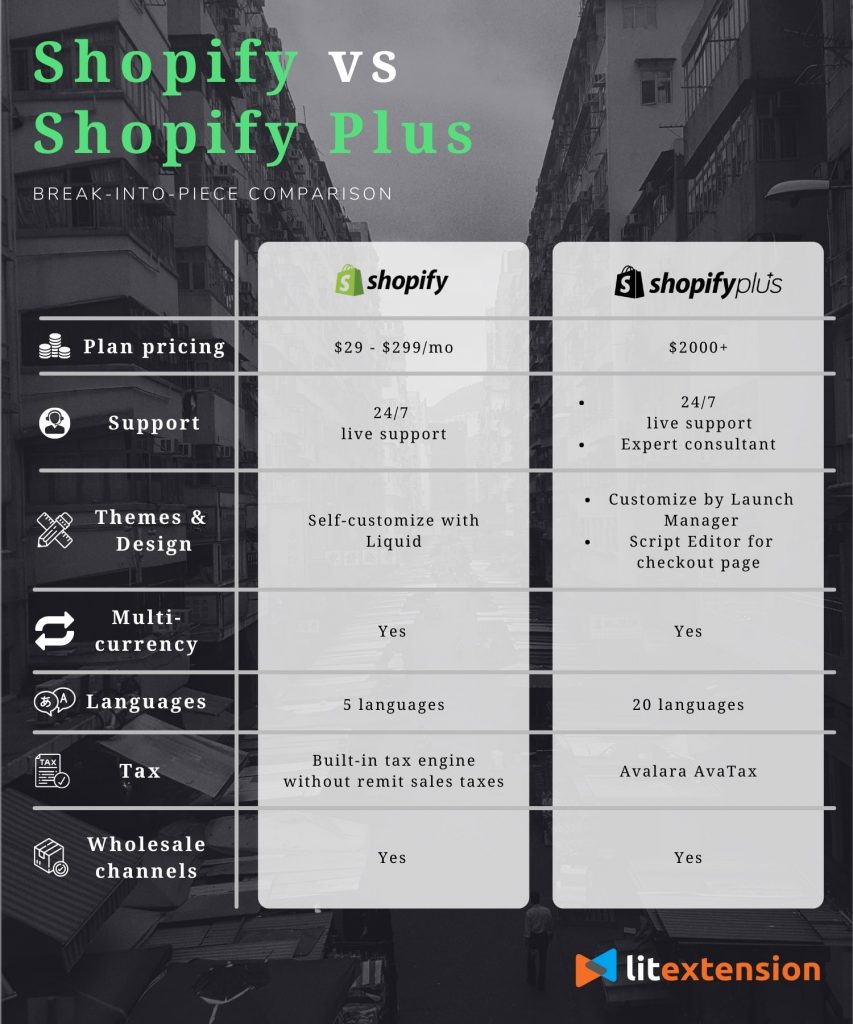
Shopify Plus’s core advantage is that it provides more control, customization and automation for your standard eCommerce store setup, combined with stronger uptime and better omnichannel services.
With Shopify Plus, you’ve got to be aware that direct pricing negotiation is compulsory. You can fill in the contact form to deal with the Shopify Plus team.
Based on your sales volume, you’ll pay at least $2000 monthly. However, if your revenue surpasses $800,000 per month, their charging system will turn into a revenue-based model. You’ll pay 0.25%, but not more than $40,000 of your monthly revenue.

Regarding eCommerce store design, you can choose from 73 themes available. Among these, there are 9 free themes and 64 paid ones which range from $140-$180. Created by design experts, Shopify themes are generally elegant and stunning yet feature-rich and mobile-optimized.
Additionally, Shopify Plus comes with the Launch Manager which can help to make custom edit as your requirements.
Apart from an eye-catching online presence, Shopify Plus also makes daily operations easier for retailers by offering several automated, advanced features.
For instance, Shopify Plus automatically selects the appropriate currency for purchasers based on their IP addresses.
Especially, there’s no need to worry about your site scalability whether it’s the hectic Black Friday season or flash sale. The stable Shopify Plus can handle thousands of transactions per minute to ensure a pleasant shopping experience for your customers.
Shopify Plus Pros
- Shopify Plus offers exceptional customer service. You’ll get a successful manager that’s dedicated to making your business shine.
- This hosted solution is way easier to set up and manage on a daily basis.
Shopify Plus Cons
- Its pricing is quite high compared to other enterprise platforms.
- Shopify Plus charges you 0.15% per transaction if you use a third-party payment processor. If you use Shopify Payments, there’s no transaction fee.
Further reading:
- All-In-One Shopify Tutorial
- Shopify Plus vs Magento Commerce Comparison
- Shopify Plus vs BigCommerce Enterprise Comparison
Final Verdict
Actually, it doesn’t matter how many platform reviews you have read before choosing an eCommerce platform for your business. There is only one person who knows exactly which platform best suits your unique blend of resources and requirements. And that person is you!
Hopefully, with our suggestions above, choosing an eCommerce platform for your business is no longer a challenging task. We highly recommend you start a free trial with all suggested platforms so that you can play around with them and make a well-informed decision before committing.
By the way, if you’re looking for more helpful eCommerce tips and news, let’s join our Facebook community right away!
